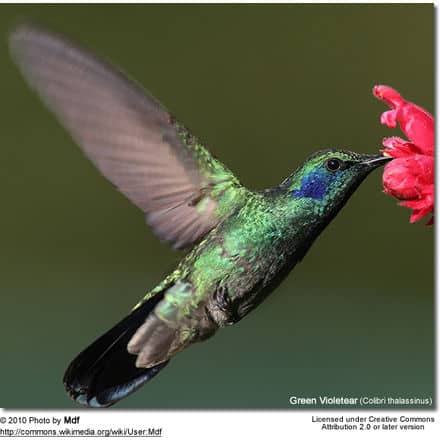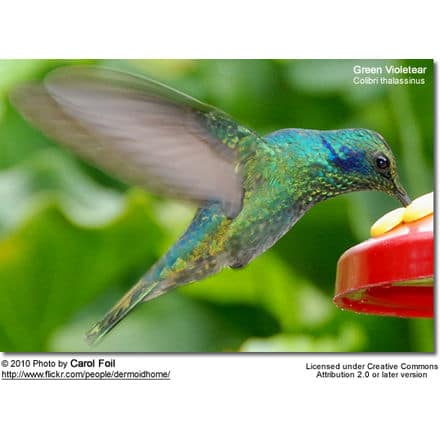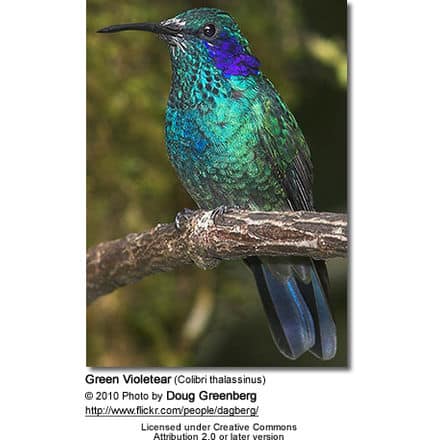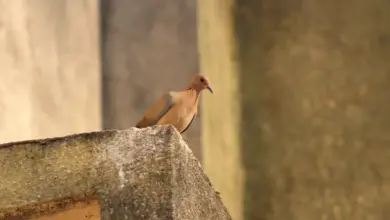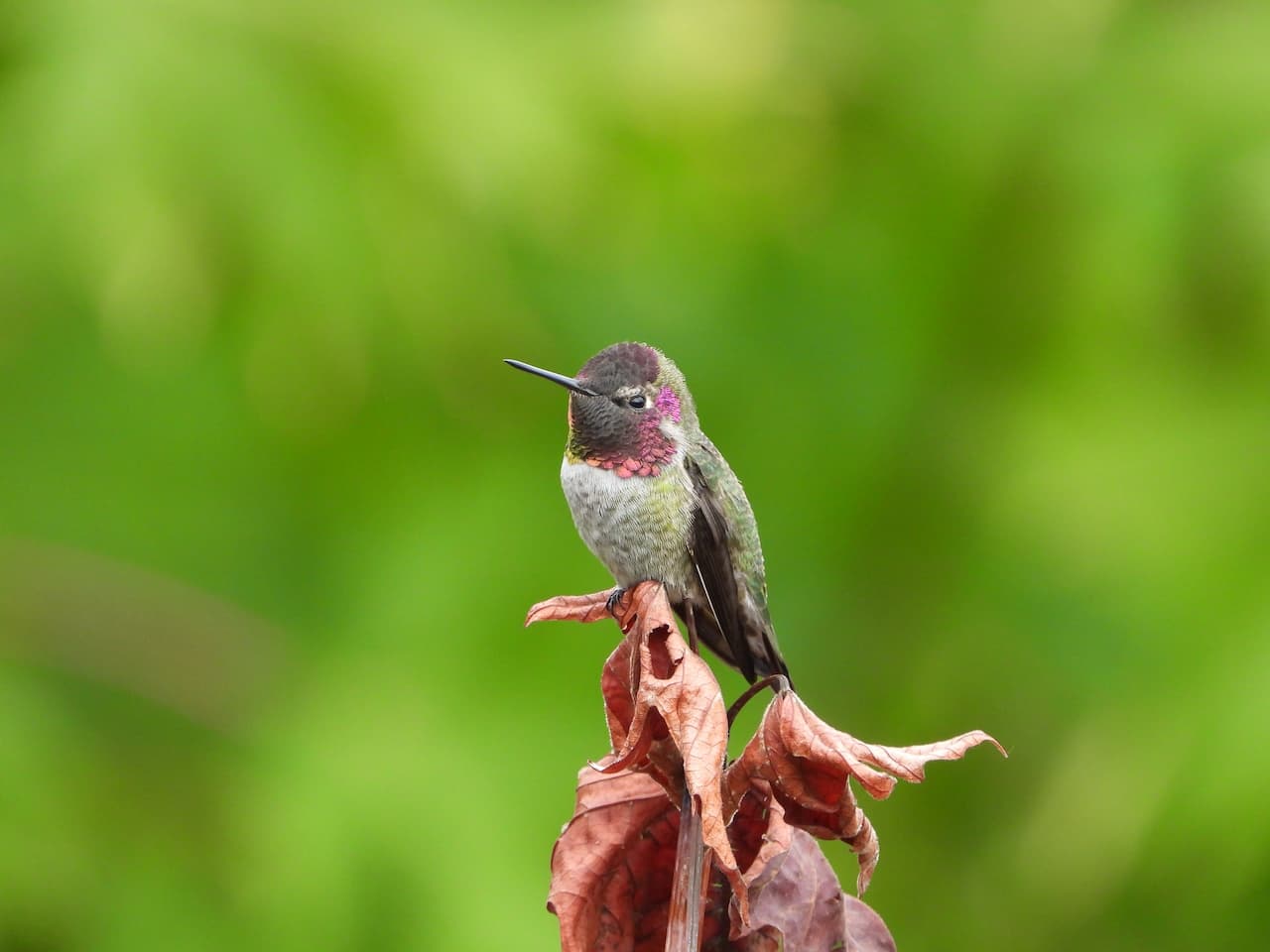Green Violet-ear Hummingbirds
The Green Violet-ears (Colibri thalassinus) – also known as Mexican Violet-ears – are colorful hummingbirds that are found in the highlands from south-central Mexico, (the Trans-Mexican Volcanic Belt), south to western Panama and in the Andes from northern Venezuela to Bolivia.
They are mostly resident in Mexico and Central America, but some seasonal movements have been observed. They may wander north to the United States (Southern California, Alabama, Kentucky, Southern Arizona, Texas, Missouri, Georgia, Florida, and), and a few travel as far as Canada.
They inhabit a semi-open upland country with trees and scrubs. In South America, they generally prefer more humid habitats (such as the edge of cloud forests) compared to the similar Sparkling Violetear, but these two can sometimes be seen together.
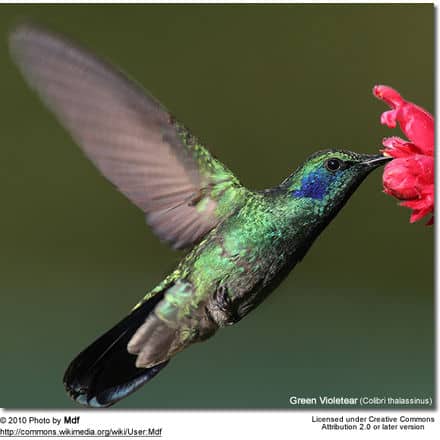

Subspecies and Distribution:
- Colibri thalassinus thalassinus (Swainson, 1827) – Nominate Race
- Found in central and south Mexico to north-central Nicaragua.
- Colibri thalassinus cabanidis (Heine, 1863)
- Found in Costa Rica and western Panama.
- Colibri thalassinus cyanotus (Bourcier, 1843)
- Found in the mountains of Venezuela, Colombia, and Ecuador.
- Colibri thalassinus crissalis (Todd, 1942)
- Found in the Andes of Peru and Bolivia, and extreme northwestern Argentina.
Alternate (Global) Names
Spanish: Colibrí Chico, Colibrí de Orejas Azules, Colibrí Oreja Violeta, Colibrí Orejivioláceo Verde, Colibrí Verdemar, Orejavioleta Verde, Orejimorada verde, Picaflor de cara azul … Italian: Colibrì orecchieviola talassino, Guanciaviola verde … French: Anaïs vert, Colibri à oreilles violettes, Colibri anais, Colibri thalassin … German: Kleiner Veilchenohrkolibri, Zwergveilchenohr, Zwerg-Veilchenohr … Czech: Kolibrík zelený, kolib?ík zelený … Danish: Lille Violetøre … Finnish: Viherorvokkikolibri … Guarani: Mainumby … Japanese: midorihachidori … Dutch: Groene Violetoorkolibrie … Norwegian: Talassinkolibri … Polish: uszatek zielony … Russian: ????????? ??????? … Slovak: jagavicka malachitová … Swedish: Blåkindad kolibri, Grön öronkolibri
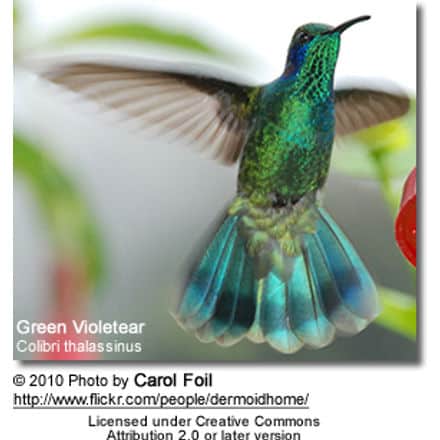
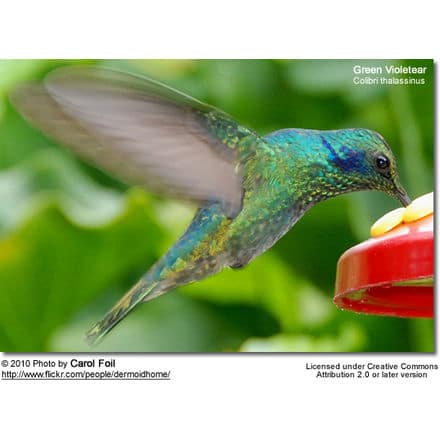
Description
The Green Violet-ears averages 11 — 11.5 cm (4.25 — 4.5 in) in length.
The adult male has a grass-green upper plumage turning into a bronze color on the rump and upper tail feathers.
The tail is square and slightly notched with a broad dark blue band at the end of the tail.
Subspecies differences:
The northern nominate subspecies has a large violet central breast spot on the upper breast and a violet-blue band along the chin that often connects to the violet-blue “ear”, giving the bird its name.
The subspecies from Costa Rica and southwards lack the violet breast spot and chin but have the violet-blue “ear feathers” of the nominate species.
The adult female is similar to the male but tends to be smaller in size, has a slightly duller plumage, and has a narrower violet band on the chin.
Immature birds: The juvenile is much duller than the adults. Its plumage is generally olive green overall with a dull gray wash to the underparts. The violet breast spot is either indistinct, incomplete, or absent. A molting juvenile may show a bright metallic color in patches, particularly on the throat or breast.
Calls / Vocalizations
The Green Violet-ears song is described as a vigorous CHEEP-chut-chut, chip CHEET – repeated throughout the day.
The call is a dry chut.
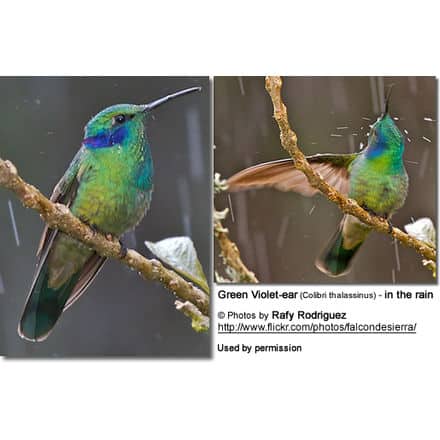
Nesting / Breeding
Hummingbirds are solitary in all aspects of life other than breeding, and the male’s only involvement in the reproductive process is the actual mating with the female. They neither live nor migrate in flocks, and there is no pair bond for this species.
Males court females by flying in a U-shaped pattern in front of them. He will separate from the female immediately after copulation. One male may mate with several females.
In all likelihood, the female will also mate with several males. The males do not participate in choosing the nest location, building the nest, or raising the chicks.
The female Green Violet-ears is responsible for building the deep, cup-shaped nest out of plant fibers woven together and green moss on the outside for camouflage in a protected location in a shrub, bush, or tree.
She lines the nest with soft plant fibers, animal hair, and feathers down, and strengthens the structure with spider webbing and other sticky material, giving it an elastic quality to allow it to stretch to double its size as the chicks grow and need more room.
The nest is typically found on a low, thin horizontal branch situated about 3.3 – 33 ft (1 – 3 meters) high in a tree.
The average clutch consists of two white eggs, which she incubates alone, while the male defends his territory and the flowers he feeds on. The young are born blind, immobile, and without any down.
The female alone protects and feeds the chicks with regurgitated food (mostly partially digested insects since nectar is an insufficient source of protein for the growing chicks). The female pushes the food down the chicks’ throats with her long bill directly into their stomachs.
As is the case with other hummingbird species, the chicks are brooded only the first week or two and are left alone even on cooler nights after about 12 days – probably due to the small nest size. The chicks leave the nest when they are about 7 – 10 days old.
Diet / Feeding
The Green Violet-ears primarily feed on nectar taken from a variety of brightly colored, scented small flowers of trees, herbs, shrubs, and epiphytes. They favor flowers with the highest sugar content (often red-colored and tubular-shaped) and seek out, and aggressively protect, those areas containing flowers with high-energy nectar.
They use their long, extendible, straw-like tongues to retrieve the nectar while hovering with their tails cocked upward as they are licking at the nectar up to 13 times per second. Sometimes they may be seen hanging on the flower while feeding.
Many native and cultivated plants on whose flowers these birds feed heavily rely on them for pollination. The mostly tubular-shaped flowers exclude most bees and butterflies from feeding on them and, subsequently, from pollinating the plants.
They may visit local hummingbird feeders for some sugar water, or drink out of bird baths or water fountains where they will either hover and sip water as it runs over the edge; or they will perch on the edge and drink – like all the other birds; however, they only remain still for a short moment.
They also take some small spiders and insects – important sources of protein particularly needed during the breeding season to ensure the proper development of their young.
Insects are often caught in flight (hawking); snatched off leaves or branches, or taken from spider webs. A nesting female can capture up to 2,000 insects a day.
Males establish feeding territories, where they aggressively chase away other males as well as large insects – such as bumblebees and hawk moths – that want to feed in their territory. They use aerial flights and intimidating displays to defend their territories.
Metabolism and Survival and Flight Adaptions – Amazing Facts
